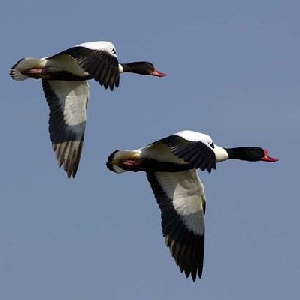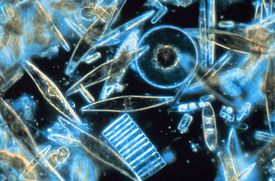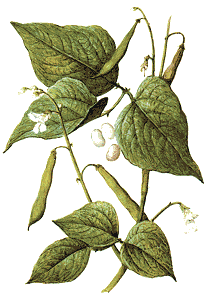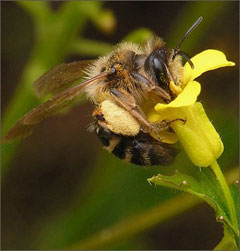The biological clock
Because of the very fast pace of life, we miss so many amazing things that, in addition, have become common for people. I made a small selection, which in my opinion is very surprising and informative.
Even before the appearance of the clocks that people invented in nature, there were many other clocks that people called biological . They work no worse than atomic clocks, but most importantly, these clocks were not invented by people ...
I want to describe some of the studies that were conducted by people, but this is only a drop in the ocean , I want you to help me add to this list a new “model” of watches.

The German scientist from Germany G. Kramer in 1945 began an experimental study of the bird orientation methods. He found that during the day the birds are guided, comparing the position of the Sun with the time that their biological clocks show. As studies have proved, for such an orientation on the Sun, the accuracy of the course of their internal clocks is very high. The error does not exceed one minute.
')
Kramer’s observations have shown that many birds (especially small ones) make nightly flights. During the day, they are forced to replenish the energy reserves consumed during the flight. Birds fly at night because there are fewer distractions at night and it’s easier for them to travel long distances.
Cramer conducted a study of daytime and nighttime bird migrations by a somewhat unusual and original method. He placed the test birds in a round cage with a glass top so that the birds could only see a portion of the sky that is at an angle of approximately 70 °. The transparent floor of the cage allowed the observer to follow the bird.
An important condition in Kramer’s experiments was from which side the light entered the cell. It turned out that the bird determined the flight direction by the Sun. She knew that in order to find the east in the morning, one had to move towards the Sun, and at the end of the day so that it remained directly behind.
In one of his experiments, Kramer "stopped" the Sun by placing a light source throughout the day on one side of the cell. And what happened? The bird "mixed up" all sides of the world, taking the east to the west at 6 o'clock. am and north to west at noon.

At low tide, microscopic algae called diatoms rise to the surface of wet shore sand. When the tide comes, diatoms again sink into the sand. However, in the sand in the laboratory, where there are no tides or ebbs, their internal clocks still cause them to rise and sink in the same rhythm.

At low tide, alluring crabs darken and crawl out of their shelter, and when the tide comes, they turn pale and hide in their burrows. In the laboratory, located far from the sea, they continue to observe the same regime, darkening and lightening depending on the time of ebb and flow.

At night, the beans drop the leaves, and before dawn raises. Maran made the most important experience: put the beans in a dark room - in the dark day and night - and observed that the movement of the leaves continued without changing the light. Maybe the beans feel the temperature change? Thermostats then was not. In 1758, Dyumel repeated the experiments of de Meran, placing the plants in a deep cave - into darkness, where the temperature was constant both day and night. The movements of the leaves continued (gradually, after many days, these movements fade, but from a very short flash of light, the movements are resumed, as if the clock was going all the time, only the leaf-arrows did not move).

For the winter, bees are sheltered from frosts and light, they become numb in their dark hives. And the clock they "go" all winter, and in the spring the bees correctly determine the time of day, which is necessary for them to choose the right direction of flight to the flowering plants for a "bribe".

Hours go even at almost full stop of metabolic processes. In these studies, the use of various poisons — inhibitors of biochemical processes (Gonyaulax marine single-celled organism) gives important results. It glows at night, following its intracellular hours. The famous green euglena, on the contrary, is inactive at night. In the daytime, she actively swims toward more light, showing positive phototaxis. It needs light for photosynthesis. At night, if a narrow beam of light is directed at a vessel with eugleans, they do not react to it, they do not show phototaxis. The onset of day and night, the green euglena determines by its internal clock. If we add to the water where these organisms live, the metabolic poisons that stop breathing and glycolysis, their vital activity stops, the euglins stop moving, the gonialaks cannot generate light. If you transfer them to a fresh environment, wash off poisons, vital activity is restored. But the most remarkable thing: it turns out that all this time their watches went quite correctly, as if the cells did not poison, after washing the poisons, they start to emit light in time and show the ability to phototaxis in time. But if poisons are added to the water, poisoning the processes of reading genetic information, for example, actinomycin D, which interferes with the functioning of RNA polymerase — the synthesis of mRNA by the DNA template — the clock is lost and their progress is disturbed. These observations were made over thirty years ago by the American researcher Hastings.

Different species have different daily activities. Drosophila of one species are active in the morning, others in the evening. Their daily periodicity is especially clearly manifested in the time of the mass hatching of adult flies from cocoons.
Sources:
http://www.vitaminov.net/rus-biological_rhythm-biological_clock-0-11826.html
http://unirefs.ru/13/dok.php?id=2654557
http://www.inventors.ru/index.asp?mode=4236
http://bio.1september.ru/articlef.php?ID=200404405
http://ru.wikipedia.org/wiki/Drosophila
PS And what biological clock do you know?
Even before the appearance of the clocks that people invented in nature, there were many other clocks that people called biological . They work no worse than atomic clocks, but most importantly, these clocks were not invented by people ...
I want to describe some of the studies that were conducted by people, but this is only a drop in the ocean , I want you to help me add to this list a new “model” of watches.
Birds

The German scientist from Germany G. Kramer in 1945 began an experimental study of the bird orientation methods. He found that during the day the birds are guided, comparing the position of the Sun with the time that their biological clocks show. As studies have proved, for such an orientation on the Sun, the accuracy of the course of their internal clocks is very high. The error does not exceed one minute.
')
Kramer’s observations have shown that many birds (especially small ones) make nightly flights. During the day, they are forced to replenish the energy reserves consumed during the flight. Birds fly at night because there are fewer distractions at night and it’s easier for them to travel long distances.
Cramer conducted a study of daytime and nighttime bird migrations by a somewhat unusual and original method. He placed the test birds in a round cage with a glass top so that the birds could only see a portion of the sky that is at an angle of approximately 70 °. The transparent floor of the cage allowed the observer to follow the bird.
An important condition in Kramer’s experiments was from which side the light entered the cell. It turned out that the bird determined the flight direction by the Sun. She knew that in order to find the east in the morning, one had to move towards the Sun, and at the end of the day so that it remained directly behind.
In one of his experiments, Kramer "stopped" the Sun by placing a light source throughout the day on one side of the cell. And what happened? The bird "mixed up" all sides of the world, taking the east to the west at 6 o'clock. am and north to west at noon.
Diatoms

At low tide, microscopic algae called diatoms rise to the surface of wet shore sand. When the tide comes, diatoms again sink into the sand. However, in the sand in the laboratory, where there are no tides or ebbs, their internal clocks still cause them to rise and sink in the same rhythm.
Alluring crabs

At low tide, alluring crabs darken and crawl out of their shelter, and when the tide comes, they turn pale and hide in their burrows. In the laboratory, located far from the sea, they continue to observe the same regime, darkening and lightening depending on the time of ebb and flow.
Beans

At night, the beans drop the leaves, and before dawn raises. Maran made the most important experience: put the beans in a dark room - in the dark day and night - and observed that the movement of the leaves continued without changing the light. Maybe the beans feel the temperature change? Thermostats then was not. In 1758, Dyumel repeated the experiments of de Meran, placing the plants in a deep cave - into darkness, where the temperature was constant both day and night. The movements of the leaves continued (gradually, after many days, these movements fade, but from a very short flash of light, the movements are resumed, as if the clock was going all the time, only the leaf-arrows did not move).
Bees (also in others)

For the winter, bees are sheltered from frosts and light, they become numb in their dark hives. And the clock they "go" all winter, and in the spring the bees correctly determine the time of day, which is necessary for them to choose the right direction of flight to the flowering plants for a "bribe".
Unicellular organisms and poison

Hours go even at almost full stop of metabolic processes. In these studies, the use of various poisons — inhibitors of biochemical processes (Gonyaulax marine single-celled organism) gives important results. It glows at night, following its intracellular hours. The famous green euglena, on the contrary, is inactive at night. In the daytime, she actively swims toward more light, showing positive phototaxis. It needs light for photosynthesis. At night, if a narrow beam of light is directed at a vessel with eugleans, they do not react to it, they do not show phototaxis. The onset of day and night, the green euglena determines by its internal clock. If we add to the water where these organisms live, the metabolic poisons that stop breathing and glycolysis, their vital activity stops, the euglins stop moving, the gonialaks cannot generate light. If you transfer them to a fresh environment, wash off poisons, vital activity is restored. But the most remarkable thing: it turns out that all this time their watches went quite correctly, as if the cells did not poison, after washing the poisons, they start to emit light in time and show the ability to phototaxis in time. But if poisons are added to the water, poisoning the processes of reading genetic information, for example, actinomycin D, which interferes with the functioning of RNA polymerase — the synthesis of mRNA by the DNA template — the clock is lost and their progress is disturbed. These observations were made over thirty years ago by the American researcher Hastings.
Drosophila

Different species have different daily activities. Drosophila of one species are active in the morning, others in the evening. Their daily periodicity is especially clearly manifested in the time of the mass hatching of adult flies from cocoons.
Sources:
http://www.vitaminov.net/rus-biological_rhythm-biological_clock-0-11826.html
http://unirefs.ru/13/dok.php?id=2654557
http://www.inventors.ru/index.asp?mode=4236
http://bio.1september.ru/articlef.php?ID=200404405
http://ru.wikipedia.org/wiki/Drosophila
PS And what biological clock do you know?
Source: https://habr.com/ru/post/67126/
All Articles